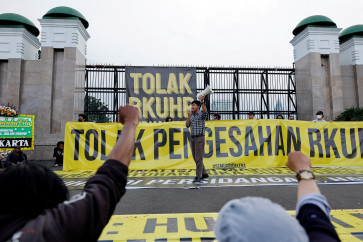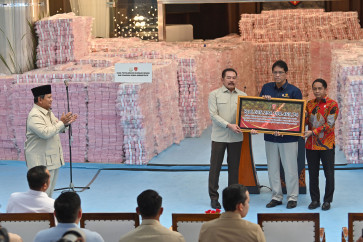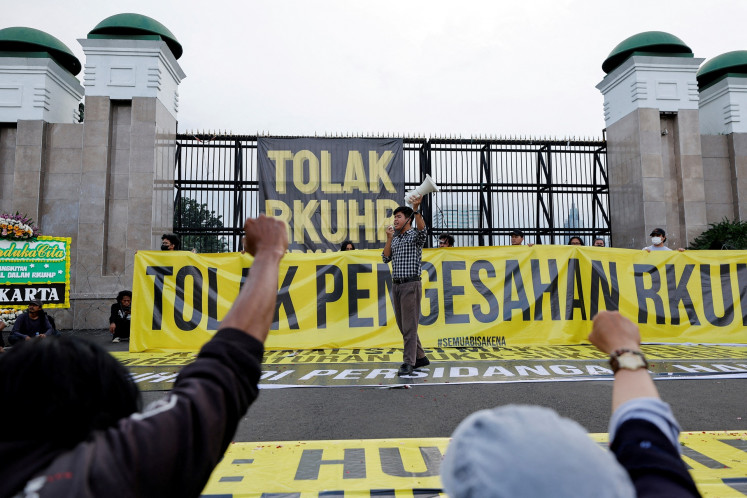Popular Reads
Top Results
Can't find what you're looking for?
View all search resultsPopular Reads
Top Results
Can't find what you're looking for?
View all search resultsImmigration, a smokescreen issue in Australia election
Controlling migration intake has become one of three top political issues in the run up to Saturday’s election here, along with climate change and education
Change text size
Gift Premium Articles
to Anyone
C
ontrolling migration intake has become one of three top political issues in the run up to Saturday’s election here, along with climate change and education.
Swinging radically from his previous position, coalition opposition leader Tony Abbott said he would reduce the number of immigrants from the current level of 300,000 to 170,000 in his first term in government if elected. Incumbent Prime Minister Julia Gillard promised a far-reaching solution by stopping people from leaving foreign shores and setting up an offshore regional processing center.
The two leaders have been under fire for using the vague term “sustainable” population policy in their speeches.
Although both are migrants themselves, they are saying no to immigration. This is certainly an irony but their stance is a display about how well they understand the public’s reservations about the issue.
Discontent about immigration dated back to the White Policy, which was abandoned in 1970s. Today it is kept alive by a steady flow of news about asylum seekers notably those arriving by boats. The stories are media pets for their dramatic-loaded element. Refugees often sail on crowded and dilapidated boats braving huge waves for weeks, often with inadequate food and safety equipment.
Quantity-wise, however, shows that Australia has taken in very few refugees compared to the world. The number of the so-called illegal arrivals is less than 3,000 as of May this year, according to the Australian Parliamentary Library, while visa of overstayers stand 20 times higher.
One can be forgiven for asking about those arriving by planes? According to an expert, Australia received only 25,000 asylum seekers in 34 years.
That argument aside, those figures look helplessly trivial to Indonesians who are used to big figures when it comes to population. All the fuss about immigration relates only to 21 million Australians, less than one-tenth of Indonesia’s 238 million.
Australians comprise twice the population of Jakarta, living on a continent four times Indonesia’s land area. One can rightly argue that 70 percent of the continent consists of desert, still a third of the continent is an immense land size.
Migration intake increased during the term of former prime minister Kevin Rudd who followed the toe of his predecessor John Howard. Rudd’s idea of a “big Australia” had not gone down well with the public and Gillard has distanced herself from it since she came to office in June.
In an interesting twist, a Victorian state opposition spokesman has broken ranks on population.
Contradicting Abbott’s “stop the boats” mantra, Matthew Guy told a summit on population in Melbourne on Wednesday that he did not mind a population growth.
So far, Australia has offered two responses to asylum seekers, the Pacific Solution and the Indonesian Solution. The first one was initiated by the Howard government in 2001 where asylum seekers were put on Nauru. The second one was started by Rudd in 2009. Asylum seekers are being kept in Indonesia. In both cases, the Australian government paid a huge amount of money to respective recipient governments.
Gillard has toyed with the idea of setting up a regional refugee processing hub in Timor Leste since she came to power, a solution now being explored.
Gillard and Abbott’s rhetoric on immigration has infuriated Australia’s migrant community groups.
Federation of Ethnic Communities of Australia head Pino Migliorino said the election was making migrant communities feel like scapegoats.
Other factors, like the lack of infrastructure and sufficient number of trains, have been the real cause of people’s frustration, he told media organization SBS in a television interview.
With all the talk about a safe population number, a comfortable population is a denial of Australia’s multicultural society and a denial of what migrants have done for Australia, he said. He said regretted the fact that politicians had been using the issue for electoral purposes.
Skill shortages are the reasons often cited as the base for the need for more migration intake. Seventy percent of migrant intakes were skilled workers, particularly during the Howard government. Economists believe that skill shortages will threaten economic growth.
One recent survey, however, has dismissed the notion that immigration has contributed to the rise of productivity. Control on population is a big concern to any government.
Unlike Australia, population growth is a given factor in Indonesia. Immigration is hardly an issue since it is not a popular immigration destination. Its population growth relies mostly on birth rate and it used to have a workable family planning program.
It may be a slower process as it needs time for a baby to become an adult but it is relatively easier to predict the growth of the population. Immigration can spur population growth as the US has shown. It all depends on how big the leeway is opened by the government in question, but it is often a more difficult process since immigrants bring their own cultural values.
The immigration issue has become a smokescreen in Australia for politicians to exploit. Many people do not seem to grasp the bottom line of the issue and they fall prey to politicians who know how to turn their ignorance to their own advantage. An open and frank discussion about the topic is in order.
In the absence of this, how the people perceive its government’s dealing with immigrants is being tested at the end of the one-month election campaign. It is interesting to see how far the issue has helped sway people’s choice come Saturday.
As for its leaders, they need only to look to the Northern Territory to improve their ways of dealing with immigrants.
The Yolgnu people in Arnhem Land can teach them about dignity and self-confidence in answering the challenge of the immigrant issue. The indigenous group had set up a cosmopolitan community as early as the 1600s and received migrants as far as Makassar, South Sulawesi. They had successfully incorporated the migrants into their community and established a harmonious society centuries before modern Australia came to being.
The writer is a journalist.










